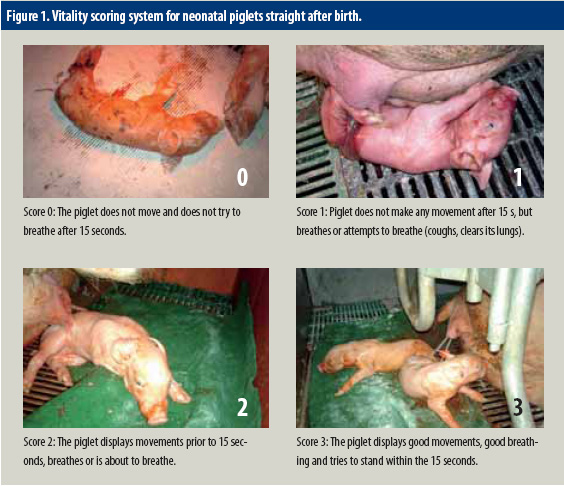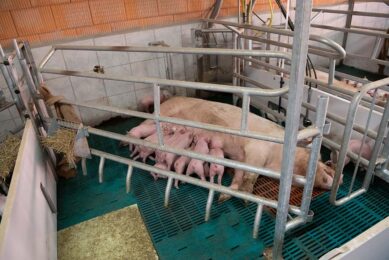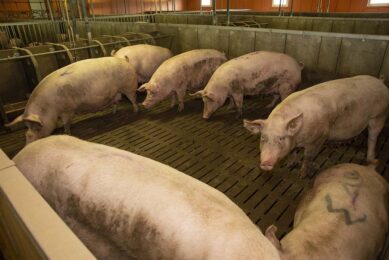Measuring piglet vitality

Vitality in piglets is a little-known notion because it is not very easy to observe and therefore not easy to describe with objectivity. The study of this parameter brings to light two phenomena: Vitality directly affects litter performances and mortality rate. In addition, vitality depends on the progression of the farrowing process (conditions, duration, etc.). These elements highlight the importance of good management of this crucial phase.
By Audrey Sacy, Lallemand Animal Nutrition
In 1997, French pig scientist Patrick Herpin and others suggested calculating a viability score at birth, and not a vitality score, in four classes. Nevertheless, the notion of vitality is addressed in their work and evaluation of vitality takes account of several criteria:
1. Interval between birth and first contact with the teat;
2. Interval between birth and first suckling;
3. Rectal temperature at 24 hours of life;
4. Weight gain and survival during the first ten days of life.This method constitutes a first approach to the notion of ‘piglet vitality’ at birth, but its use can sometimes prove difficult or confusing. Lack of precision and difficulty in evaluating certain criteria (e.g. first suckling: Effectively taking the teat in the mouth or suckling?) or material and human constraints make the method too complicated to use routinely.
Moreover, it requires a comparison of several data types, which are not always strictly correlated.The most recent publication published on the subject offers a simple scale focused on the first 15 seconds of life of the piglet, enabling the piglets to be classified according to four levels of vitality, devised by English scientist Emma Baxter and others in 2008. The scale is very similar to the viability score evaluation of Herpin – and is explained in detail in Figure 1.This scoring system was used in the study discussed in this article, performed by a team of scientists from Lallemand on a commercial 400 sow farm in France in 2008.
Before presenting results, it is essential to bear in mind that early postnatal vitality is directly linked to hypoxia during parturition. The weakest piglets at birth are generally those which have been exposed to anoxia during farrowing.
Piglet weight
The results confirm the correlation between piglet weight at birth and vitality (Figure 2). Vitality scores of the different weight classes are all significantly different, except for classes 2 and 3 which indicate a clear trend. These results don’t appear illogical considering the conclusions of Herpin, which specify that small piglets, because of their lower capacity to restore their homeostasis when faced with prolonged stress, and their tendency to come late in the farrowing process, would be more prone and sensitive to intrauterine hypoxias, which are synonymous with loss of vitality.
Birth rank and farrowing duration
Piglets delivered first in their litter have greater vitality than piglets delivered last in the litter. Mean birth ranks of different vitality classes are all significantly different (see Table 1). This data confirms the idea that an increase in the time spent in the vaginal tract raises the risks of hypoxia and affects piglet vitality. Piglets born last therefore tend to be the limpest, a phenomenon which will become more marked with the lower quality of the colostrum intake (for an equal quantity), etc. All these parameters inevitably damage the piglet’s subsequent chances of survival.
Unsurprisingly, in these trials, the same tendency was found if mean vitality is correlated with the progression of the farrowing process: piglets delivered at the beginning of parturition are more vigorous than those who come later. A large drop in vitality was noted for the piglets born after the third hour, which in practice are often distinctly less robust than their predecessors and sometimes require resuscitation. Finally, analysis of the data shows a parity effect: the piglets with 0 vitality have a greater tendency to come from old sows, whereas the highest vitality scores are from young multiparous sows, as can be seen in Figure 3. The data seems consistent, considering the conclusions that we have been able to draw in the earlier chapters: old multiparous sows are more prone to farrowing difficulties, non-optimum conditions, and human interventions, and we have also established that they generate higher mortality rates at birth.
Performances
The performances of the high-vitality piglets after three days are clearly better than those of the weakest piglets; they are less active at feeding, and the quality of the colostrum has already deteriorated (immunoglobulin level, etc.). This can be seen in Figure 4. Furthermore, we know that these piglets are largely disadvantaged when competing with the rest of the litter.
Nevertheless, we note that performance imbalance is compensated for at weaning, and this kind of result cannot be generalised because it appears to derive from a particularity of the farm being studied: a fostering policy would tend to reduce inequalities and mortality rates in lactation period.
Mortality
Mortality rates on day three rise for low vitality scores: piglets’ lack of sturdiness may lead to reduced diet and performances, but it also sometimes generates major deficiencies, leading to the death of the piglet. This trend continues during the maternity process (compare this to mortality on day 21). The notion of vitality is therefore linked to that of mortality – see Figure 5.
References available on request.This article is an abbreviated version of ‘Zoom on… Objective: Vitality’, published by Lallemand Animal Nutrition. The company published five ‘Zoom on…’ booklets, around the theme of the peri-partum phase in pigs.











